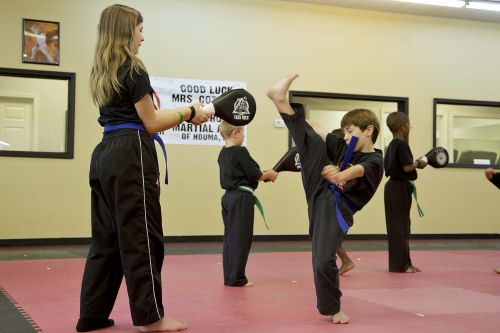Crime Blotter: Reported offenses in the Tri-parishes
July 9, 2013
Gumbo contributor partakes in rodeo, nabs unique catch
July 11, 2013When addressing their instructor, they punctuate their phrases – or more commonly, one-word responses – with “Sir.”
This unusual behavior extends to counting. Each jumping jack, push-up and crunch is noted aloud, followed by the one-syllable deference.
“We’re developing responsible citizens for tomorrow,” said William Cothren, owner of a three taekwondo studios, including Cothren’s TKD-Houma on St. Charles Street. “If we didn’t teach them here, where we they learn it? … It is about creating a foundation.”
Cothren is hardly alone. Taekwondo, like many styles in the martial arts amalgam, adheres to a dogma rooted in respect. Hand-to-hand combat training is the surface picture and ultimate goal, but the path to its black belt is guided by principles and mental checkpoints.
For the sake of illuminating one martial-arts style beyond a cursory glance, taekwondo is this story’s focus. An Olympic sport and mainstream American hobby, it shares some qualities with other styles, such as karate. Both are empty-handed forms of self-defense, for example, but the Korean-originated taekwondo puts more emphasis on kicking and was built from different customs than the Japan-based karate. With the rise of mixed martial arts cage fighting, Muay Thai and Brazilian jiu-jitsu have proven to be superior combat means than taekwondo, which on the Olympic level is a point-based competition that rewards accuracy, as well as power.
Aside from the acrobatic kicks it features, taekwondo is most known for its belt structure, which identifies a student’s rank and dictates what skills he or she is able to learn (see belt structure).
Cothren conducts belt-promotion tests every four to six weeks. In addition to performing the skills and forms learned in front of a judge, students who aspire for a promotion must meet class attendance benchmarks and possess the ranks – stripes on a belt – to move up. “Just like reprimands, you also have to have atta-boys,” Cothren said. “Each student has to feel that they’re wanted in the program.”
Green belts are permitted to spar, and their skill training focuses on balance, movement and targeting.
“We always (at the green-belt level) say light-to-no contact. We want you to get close; we don’t want you to hit yet. … We do sparring more as cardiovascular and basic defense: If someone attacks you, where do you kick them, how do you kick them and how to move.
“It’s harder to teach someone how to kick fast with light contact than it is to say, ‘Just kick him and clobber him.’ … It’s self-control.”
At the blue-belt level, pupils learn how to break boards, another aspect that has crossed over into popular culture. “Now I can take that (green-belt) information and apply power to it and break a board,” Cothren said.
Skills continue to progress until the black belt, often incorrectly seen as the conclusion of training, Cothren said. “In reality, that’s the beginning. The intensity of the workout (changes).” It takes years to progress ranks on the black-belt level. With gratification so far removed, dedication is tested.
And because students are building on their fundamentals, they become more aware of their physical limitations at this level. A person’s body size and flexibility will determine how efficiently they can move, and though these limitations won’t affect progression at any taekwondo level, it does provide a better understanding of oneself, Cothren said.
“This is not about super athlete,” he said. “This is about putting you to test against yourself. … What does doing a split have to do with life-long dedication and hard work?”
The Tiger-Rock master said his instructor to student ratio is what sets his studio apart from other martial arts academies. He has six internationally certified instructors on staff and 13 nationally certified teachers to serve about 160 students, who take classes over six days.
“This is a school. It’s like higher education,” Cothren said. “We focus on the whys behind a technique. Why do you have to pivot that base foot and roll that hip over? Why do you want the leg to come through instead of glancing up?”
Cothren owns three studios – in Houma, Thibodaux and Laplace. He bought into the Tiger-Rock Martial Arts franchise, which exacts its own philosophies and principles. The organization – “the largest martial arts franchise in the world,” Cothren said – emphasizes posture alignment, weight management and controlled acceleration, among other body disciplines.
Base membership here, which includes four classes a week and access to a fitness facility, costs $95 per month.
The Tiger-Rock World Championships are July 11-13 at the Ernest N. Morial Convention Center, 900 Convention Center Blvd. It is here where Cothren’s wife will receive her sixth-degree black belt.
“It is a life-long thing,” said Cothren, a 20-plus-year taekwondo veteran who will test for his seventh-degree black belt in two years. “It has taken me six years to go from sixth-degree to seventh-degree. It is not as much about a stringent physical test as it is dedication – dedication to your students, dedication to the art of taekwondo, dedication to the community. … It’s more than just training. It’s a way of life.”
– editor@gumboguide.com
Blue belts train at Cothren’s TKD-Houma, a Tiger Rock Martial Arts Academy. Below, owner William Cothren speaks with a group of white belt pupils.








